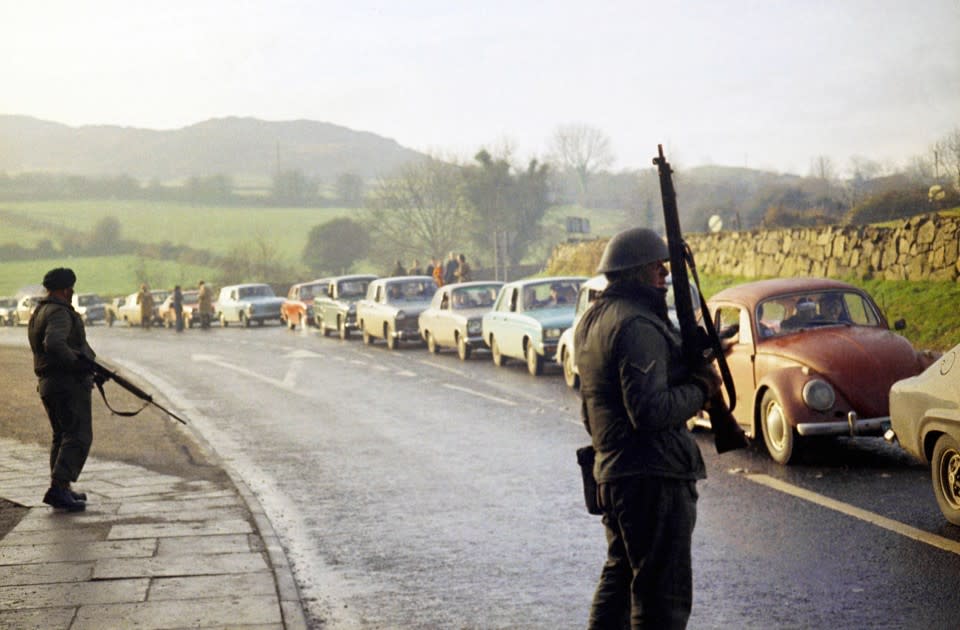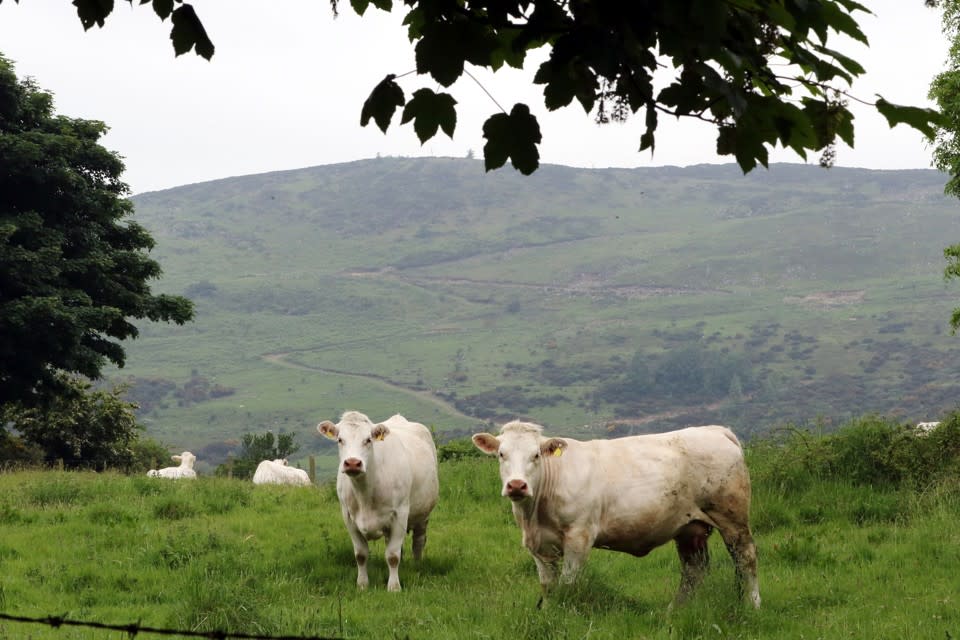Where the Brexit Stakes Are Highest
FERMANAGH, NORTHERN IRELAND—The road winds between a rough patchwork of fields, hedges rising on each side to form a green tunnel that at times hides the landscape from sight. It is just wide enough for George Colgan’s little black Ford, which he slowed to a crawl to point out a shallow ditch of water running beneath the road.
“You could miss it all right, but that there is the border,” he said with a curt nod.
Outsiders might not notice the crossing from one country to another. But this small stream is the division between the Republic of Ireland, which broke away from British rule almost a century ago, and Northern Ireland, which remains part of the United Kingdom together with England, Scotland, and Wales.
Here, the approach of the United Kingdom’s June 23 referendum on whether to leave the European Union, also known as “Brexit,” has brought uncertainty to a region with a volatile history. A vote to leave would put Northern Ireland outside the EU, while Ireland would remain within it. In that case the meandering boundary, a cause of bitterness and bloodshed since its creation in the 1920s, could become not just a division between two countries, but also the only land border between the United Kingdom and the world’s biggest trading bloc.
Recommended: Brexit: A Tale of 'Ancient Ethnic Hatreds'
That border, rendered all but invisible in recent years in part by EU trade and political deals, might then reappear as a firm dividing line between deeply connected communities on either side, though it’s anyone’s guess what form it might take. Regardless, the prospect is politically explosive on the island. Enda Kenny, the Republic of Ireland’s Taoiseach or prime minister, has warned of the effect it might have on peace in Northern Ireland, which was the site of a decades-long bloody battle between a largely Protestant unionist majority wishing to remain in the United Kingdom, and a largely Catholic nationalist minority seeking to unite with the independent, majority-Catholic Republic of Ireland to the south. The conflict, known as the Troubles, killed more than 3,500 from the late 1960s until a peace agreement backed by Britain and the United States stopped most of the fighting in 1998; along with Northern Ireland’s capital Belfast, the border areas bore much of the violence. The EU has pumped funding into projects to promote cohesion, and the region’s peace agreements are underpinned by EU law.
“We can’t go back to the way things were.”
Colgan, a steel-haired father of five who grew up about 50 yards inside of Northern Ireland and who until recently made a living driving a meat truck, has spent his life navigating the border. He recalled being woken one night, at the age of 11 or 12, to the sound of an explosion; it was the nearest crossing, the Lackey Bridge, being blown up. “I was lying in bed and I just heard a huge boom,” he said, glancing toward it as we drove past. “I had been playing underneath the bridge just the day before.” Afterward it was barricaded by the British army, which cut the parish in half and isolated the major town of Clones on the Irish side of the border. Economic decline followed. Daily tasks like going to work, school, or church, meant passing through checkpoints. “The army could hold you up for four hours before the police intervened,” he said. “If I’d be going to the doctor I’d go through the fields. It’d be quicker than going through the checkpoints.”

The Lackey Bridge remained closed until Colgan was a grown man. Today, it is a bucolic stone crossing over a small stream. The only sign of division is the faded paint on its curbstones, which are daubed in the green, white, and orange of the Irish tricolor. Colgan still lives on the United Kingdom side, but uses an Irish cell network because the signal is better. He buys groceries using British pounds in the north and ducks south to fill his car with cheaper gas, which he pays for in euros. To reach Clones from his home, Colgan must cross the border four times, as it zig-zags erratically across the road and back again.
Recommended: The 'Brexit' Campaign: A Cheat Sheet
“We can’t go back to the way things were,” Colgan said.
* * *
The adjoining villages of Belcoo, Northern Ireland, and Blacklion, Ireland, lie just either side of the border. On weekends, the local pub in Blacklion, the Dugout, fills with construction workers who earn pounds on the northern side of the border and cross over to spend them on beer denominated in weaker euros.
“There’s not enough information. We don't know what's going to happen,” 21-year-old Dylan Melanophy, a mechanic who lives just over the U.K. side of the border, told me. James Gallagher, a 58-year-old bus driver, remembered very different times, when the area saw bombings, mine attacks, and shootings by Irish Republican Army snipers. “The biggest problem for the likes of us would be the checkpoints back,” Gallagher warned the younger men, with one hand on his beer. “We'd be back to what we were used to 30 years ago, checkpoints and being stopped. I don't think it would help trade. If you're back to borders again it'll be bad for everyone.”
Customs checks disappeared in 1993, when both the United Kingdom and Ireland became members of the European single market that allows for free movement of goods and services; with the Good Friday Agreement five years later, the area’s fortified watchtowers were dismantled, and one by one the back roads were opened again. Cross-border trade in manufactured products on the island was worth an estimated 3 billion euros in 2014. Given its dependence on this trade, Northern Ireland could be worse hit by economic losses than the rest of the United Kingdom should Brexit pass. (The organization for Economic Cooperation in Europe has estimated that the U.K. as a whole will suffer economically due to lost trade in the event of a Brexit, though economists favoring British exit say such fears are overblown.)
Recommended: How American Politics Went Insane
These days, 64-year-old Gerry Mullally, a lanky farmer who owns 50 cows just inside the U.K., can sell his milk in Ireland with no need for checks. His 33-year-old son Neil lives on the Irish side of the border and comes back and forth to help with the farm. One word sums up how the vote might affect their business: uncertainty. “It's a total gray area. We don't know,” said Mullally over a cup of tea with his wife Bernie in their farmhouse kitchen. “If there is a Brexit vote there’ll be two or three years of upheaval.”
In the Mullally household, the EU shows up in the form of glossy leaflets that drop through the letterbox, explaining regulations about everything from fertilizer to cow pens, and carrying the dreaded prospect of inspections. The EU’s common agricultural policy is the bloc’s single biggest expense, taking up 39 percent of its budget in 2013, and perhaps its most controversial. Subsidies to farmers have at times encouraged overproduction of certain goods, resulting in so-called butter mountains and wine lakes that at various points have stood as monuments to EU inefficiency. Gerry himself gets subsidies, which can be worth 329 euros per hectare annually (about $372) up to a maximum of 150,000 euros. He welcomes the help, but wishes the system could be simplified. The 2016 booklet of rules for claiming subsidies issued by the British government runs to 118 pages. Inspectors once came to Mullallys’ farm to walk around the hedged perimeter and make sure he was claiming the correct amount. The family isn’t sure whether they can trust promises by pro-Brexit campaigners that the U.K. would replace the subsidies if it left the EU.

“It's very hard to know what to believe,” said Bernie, tucking back her neatly styled hair. She has resolved to cast her ballot in favor of remaining in the EU. “The uncertainty is the last thing we need.” But Gerry is deeply frustrated with the regulations and isn’t sure how he will vote. In any case, the couple reasoned, their votes may count for little. England is home to some 53 million people, while Northern Ireland has less than 2 million.
“It doesn’t matter if every man, woman, and child in Northern Ireland votes to stay in,” Bernie shrugged. “England will decide it because of the population.”
* * *
Like everything from religion to sports allegiances, the issue of the United Kingdom’s membership of the European Union has split roughly along nationalist and unionist lines within Northern Ireland. The Democratic Unionist Party, Northern Ireland’s largest political group, is campaigning in favor of Brexit. The biggest nationalist party, Sinn Fein, is campaigning against it, on the grounds that Britain’s withdrawal from the bloc would harden the border between Northern Ireland and Ireland that they seek to dismantle. The party has said that if Britain votes to leave the EU, Northern Ireland should be granted a vote on whether to re-unite with Ireland, though given the country’s unionist majority it’s doubtful such a referendum would pass. Even so, any move toward such a vote would face uproar from the unionist community, for whom even symbolic changes can be provocative. A 2012 decision to reduce the days on which the British Union Jack flag was flown from Belfast’s City Hall sparked weeks of protests and riots.
And if a hardened border carries risks in the event of a Brexit, so does a permeable one. A driving force for the U.K.’s campaign to leave the EU is concerns over immigration. Citizens of any of the EU states are currently free to travel to both the U.K. and Ireland as fellow members, and the U.K. and Ireland have a Common Travel Area of free movement that dates back to independence—interruptions during the Troubles notwithstanding. But if the United Kingdom withdraws from the EU’s free movement area while Ireland does not, that free travel might have to be curtailed. Otherwise, any member of an EU state could simply cross into the U.K. from Ireland.
"I support patrols, active patrols. We need to have the army asserting our sovereignty,” David McNarry, the Northern Ireland chair of the anti-EU U.K. Independence Party told the Daily Express newspaper last month. “It's a hell of a job to ask anybody to do but if you leave it then it's wide open for migration, for the clever traffickers, for the criminals.” Ireland’s official guidance on the referendum states that a solution would have to be hashed out in negotiations with the U.K. and the EU following the referendum. “The matter is not fully within our hands,” it reads.
There are others who, like McNarry, would welcome a return to a harder border. On the sidelines of a loyalist march just inside Northern Ireland in May, one gray-haired couple confided they would feel safer if the roads from the south were blocked again. “I would have gone to school when I was a little girl on the other side of the border and we would have had our bags searched by the soldiers and so on,” said the woman. Wary of her security, she did not want to be publicly identified as an attendee of the loyalist march. The Newtownbutler Border Defenders band marched by in colorful uniforms.
“We didn’t mind. There was a reason for it.” With her arms crossed firmly over her lilac blazer, she declared that she was voting for Brexit. “We managed before and we'll manage again.”
Read more from The Atlantic:
This article was originally published on The Atlantic.


